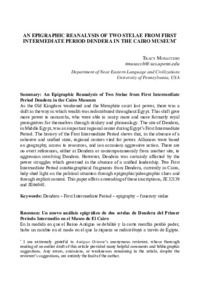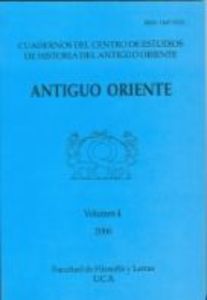Please use this identifier to cite or link to this item:
https://repositorio.uca.edu.ar/handle/123456789/11838| Título: | An epigraphic reanalysis of two stelae from First Intermediate Period Dendera in the Cairo Museum | Autor: | Musacchio, Tracy | Palabras clave: | ESTELAS FUNERARIAS; YACIMIENTOS ARQUEOLOGICOS; HISTORIA DE EGIPTO; HISTORIA POLITICA | Fecha de publicación: | 2006 | Editorial: | Universidad Católica Argentina. Facultad de Filosofía y Letras. Centro de Estudios de Historia del Antiguo Oriente | Cita: | Musacchio, T. An epigraphic reanalysis of two stelae from First Intermediate Period Dendera in the Cairo Museum [en línea]. Antiguo Oriente. Cuadernos del Centro de Estudios de Historia del Antiguo Oriente. 2006 (4). Disponible en: https://repositorio.uca.edu.ar/handle/123456789/11838 | Resumen: | Summary: An Epigraphic Reanalysis of Two Stelae from First Intermediate
Period Dendera in the Cairo Museum
As the Old Kingdom weakened and the Memphite court lost power, there was a
shift in the way in which wealth was redistributed throughout Egypt. This shift gave
more power to nomarchs, who were able to usurp more and more formerly royal
prerogatives for themselves through titulary and phraseology. The site of Dendera,
in Middle Egypt, was an important regional center during Egypt’s First Intermediate
Period. The history of the First Intermediate Period shows that, in the absence of a
cohesive and unified state, regional centers vied for power. Alliances were based
on geography, access to resources, and (on occasion) aggressive action. There are
no overt references, either at Dendera or contemporaneously from another site, to
aggression involving Dendera. However, Dendera was certainly affected by the
power struggles which governed in the absence of a unified leadership. Two First
Intermediate Period autobiographical fragments from Dendera, currently in Cairo,
help shed light on the political situation through epigraphic/paleographic clues and
through explicit content. This paper offers a rereading of these inscriptions, JE 32139
and JE46048. Resumen: Un nuevo análisis epigráfico de dos estelas de Dendera del Primer Período Intermedio en el Museo de El Cairo En la medida en que el Reino Antiguo se debilitó y la corte menfita perdió poder, hubo un cambio en el modo en el que la riqueza se redistribuyó a través de Egipto. Este cambio dio más poder a los nomarcas, quienes pudieron usurpar más y más prerrogativas regias para ellos mismos, a través del uso de la titulatura y fraseología propias de los reyes. El sitio de Dendera, en el Egipto medio, fue un importante centro regional durante el Primer Periodo Intermedio egipcio. La historia del Primer Periodo Intermedio muestra que, en ausencia de un Estado cohesionado y unificado, los centros regionales rivalizaban por el poder. Las alianzas estaban basadas en la geografía, el acceso a los recursos y (en ocasiones) en acciones agresivas. No existen referencias manifiestas de agresión relacionadas con Dendera, ni en la misma Dendera ni en otro sitio contemporáneo. Sin embargo, Dendera fue por cierto afectada por las luchas de poder que se produjeron en ausencia de un liderazgo único. Dos fragmentos de inscripciones autobiográficas pertenecientes al Primer Período Intermedio, provenientes de Dendera -que actualmente se encuentran en El Cairo- ayudan a echar luz sobre la situación política por medio de pistas paleográficas y epigráficas y a través de su contenido explícito. Este trabajo ofrece una relectura de estas inscripciones, denominadas JE 32139 y JE 46048. |
Cobertura Espacial: | Egipto | URI: | https://repositorio.uca.edu.ar/handle/123456789/11838 | ISSN: | 1667-9202 | Disciplina: | HISTORIA | Derechos: | Acceso abierto | Fuente: | Antiguo Oriente. Cuadernos del Centro de Estudios de Historia del Antiguo Oriente No.4, 2006 |
| Appears in Collections: | AO - 2006 nro.4 |
Files in This Item:
| File | Description | Size | Format | |
|---|---|---|---|---|
| epigraphic-reanalysis-two-stelae.pdf | 263,81 kB | Adobe PDF |  View/Open | |
| antiguo_oriente04.pdf.jpg | 3,75 kB | JPEG |  View/Open |
This item is licensed under a Creative Commons License

